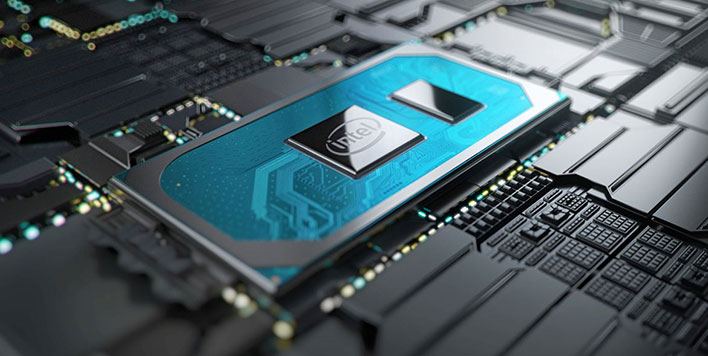Intel Gen 11 Graphics Takes Fight To AMD In Dell XPS 13 2-In-1
Dell XPS 13 2-in-1 With Intel Ice Lake Stretches Its Legs In Gaming Benchmarks Vs AMD
It's no secret that Intel has a lot riding on its "Ice Lake" 10th generation Core CPUs manufactured on its 10-nanometer fabrication process. The chipmaker got by on squeezing more power and efficiency out of its 14-nm node for what seemed like an eternity, but we're talking about a mobile sector that relentlessly demands more performance and longer battery life. This oft-delayed Intel process node promises to reduce power consumption and increase performance by a wide margin over the Kaby Lake Refresh processors that previously served as the brains for thin and light PCs.
Dell's XPS 13 2-In-1 Gets Ice Lake Engine Under The Hood
One of the first Ice Lake systems available at retail is Dell's XPS 13 2-in-1 7390, a 13" convertible laptop with a 360-degree folding hinge and an Ice Lake-derived Core i7-1065G7 with four CPU cores and Iris Plus graphics. Intel promises the Sunnycove processor cores deliver 18% higher instructions per clock (IPC) throughput than its predecessor. Ice Lake's graphics engine got a significant boost, too, however. The Core i7-8665U only has 24 execution units (EUs) based on Intel's 9th-generation graphics architecture, but the Core i7-1065G7 fits a whopping 64 EUs based on the company's newer Gen 11 GPU architecture into the same default TDP of 15 watts. These latest Core processors also support much faster memory configurations; this system boasts 16 GB of LPDDR4-3733 memory. That clock speed is more than 50% faster (by megahertz) than the DDR4-2400 memory in our recent Kaby Lake reviews like the Lenovo ThinkPad X1 Carbon. Graphics performance is what we'll focus on today—don't worry, a full review of the XPS 13 2-In-1 7390 is coming—and that's a task which will stretch this faster memory subsystem along with the integrated GPU.
When we first got a look at Ice Lake, the Core i7-1065G7 wasn't packed into a tight retail notebook enclosure, but rather was integrated into Intel's hardware and software development platform, which wasn't exactly a thin and light notebook, nor were its drivers thoroughly optimized. The XPS 13 2-In-1 we have on hand is a light hybrid notebook with a 360 degree hinge, a touch-enabled 1920x1200 (16:10 lovers, rejoice!) display and—most importantly—only weighs in at 2.9 pounds. It'll be very interesting to see if the thermal solution in this featherweight holds back the integrated CPU and GPU combination, which is configured with an optional 25-watt TDP, or if maybe driver enhancements over the last three months have allowed Intel to wring out additional performance. To find out, we're testing the XPS 13 2-In-1 7390 against the Intel prototype whitebook in both of its thermal configurations, along with a Ryzen 7 3700U (in a Lenovo T495 laptop), which is incidentally somewhat thermally limited by its 15 watt TDP. However, 15W Ryzen 7 3700U devices that use on-processor graphics appear to be the only configurations generally available currently. The higher TDP Ryzen notebooks we found available at the time all had discrete GPUs.
Intel Gen 11 Graphics Gaming Benchmarks With A Retail Laptop
|

Right out of the gate we can see that something got us a little extra performance. Driver enhancements are possible, but it's also possible that the additional memory and memory bandwidth of our XPS 13 2-In-1 allowed the iGPU to get more of the game cached at any given time. 8 GB is enough for some light gaming, but when you don't have any discrete VRAM, 16 GB is preferable. In this case, it's the difference between coming up just short of the Ryzen 7 3700U and beating AMD's chip by around 15%. Dell's portable system has both much more memory bandwidth and a larger pool of rendering resources than the Kaby Lake systems we recently reviewed. Speaking of which, Intel's 8th-gen CPU got left behind in dramatic fashion, as the new chip ran the game nearly 150% faster than its predecessor.
|

This time out, we didn't gain any extra performance from the XPS 13 2-In-1 over Intel's development system. That's unfortunate because in this configuration, Shadow of War is just not playable. Dropping the resolution down to 1600x900 almost pushed the system to 30 frame per second, but it would really require either a lower resolution still or lower details to be enjoyable. Integrated graphics of all stripes are just not capable of keeping up with this one at our selected settings.
|

Once again, we couldn't get playable frame rates out of our chosen settings. Just like Hitman, the Iris Plus's performance in our Dell XPS 13 2-In-1 was a little faster than that of the Intel's development system. It seems having a small retail-ready body doesn't limit our Ice Lake CPU's performance over a relatively short period like it takes to run a benchmark, but we'll see how it does over the long haul in our full review. Right at a single frame per second separated our competitors, but subjectively, Vulkan was a bit jerkier than the DX12 render path. Both Strange Brigade and Hitman provide frame time data without any third-party tools like CapFrameX, so we'll take a look at that in our full review as well. Meanwhile, you can see that Intel Gen 11 graphics are again markedly faster than its previous generation architecture, to the tune of about 75% here.
Find Dell's new XPS 13 7930 at Amazon








